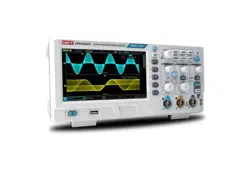Loading ...
Loading ...
Loading ...

47 / 99
The data sent each time is according to the following rules: send one start bit firstly, then 5 to 8 is data
bits, the next is optional parity bits, and the last is one or two stop bits. The number of data bits is agreed
upon by the two communicating parties and can be 5 to 8 bits, no parity bits, or select odd or even parity.
Stop bit can select one or two bits. In the following description, one data string transmission is referred to
as one frame, as shown in figure below,
(1) Information Source
The information source which is trigger source, CH1 and CH2 can be selected. The current selected
source will displayed in the upper right corner of the screen.
Note: Only the channel that has been connected to the signal, select it as the trigger source that can
get the stable trigger and correct decoding.
(2) Baud Rate
When RS232 is asynchronous transmission communication, there is no accompanying clock signal
during data transmission. In order to solve the determination of data bits, the protocol stipulates that
both parties of communication should agree on the bit rate. Usually, the bit rate is defined as the
number of bits that can be transmitted in 1s. For example, 9600 bps means 9600 bits can be
transmitted in 1s. Note that the start, data, parity and stop bits are all counted as bit, so the baud rate
does not directly equal the effective data rate. The oscilloscope will sample the bit values according
to the setting baud rate.
Baud rate can choose 2400 bps, 4800 bps, 9600 bps, 19200 bps, 38400 bps, 57600 bps, 115200
bps, 128000 bps, 230400 bps, 460800 bps, 921600 bps, 1382400 bps, 1843200 bps, 2764800 bps
and user-defined. The baud rate can be adjusted via the Multipurpose knob or jog dial when user-
defined is selected.
It is recommended to set the baud rate based on the hardware and software of RS232
communication protocol. Due to the basic model of this transmission protocol, RS232 protocol is
usually used for short distance (under 20m) and low speed (under 1 Mbps) transmission.
Communication beyond this range is susceptible interference and unreliable.
Loading ...
Loading ...
Loading ...
